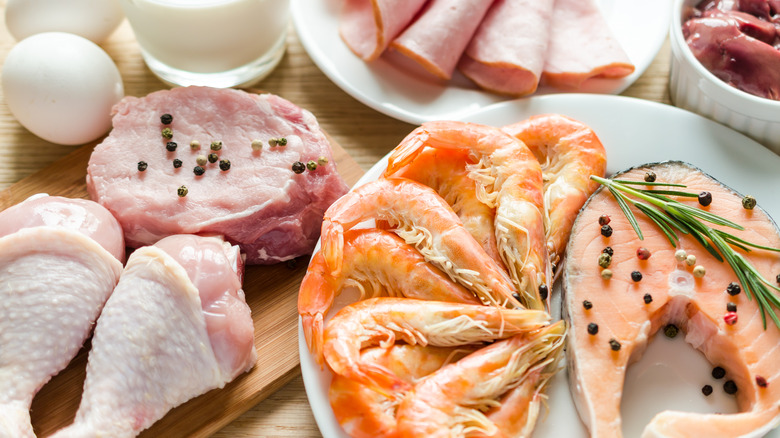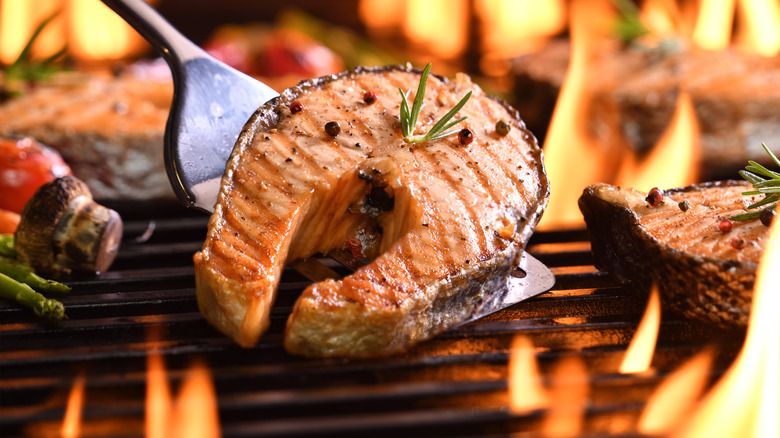Chicken Versus Fish: Which One Is Healthier?
Both chicken and fish are prized for their high protein content, but which one is healthier? The answer depends on a number of factors, such as the type of fish or chicken cut and how you cook them. For example, fried chicken wings are loaded with carbs and trans fats. A 3.5-ounce serving boasts 310 calories, 11 grams of carbs, 21 grams of protein, and 20 grams of fat, including 5.4 grams of saturated fat, according to My Food Data. Roasted chicken breast, by comparison, has just 165 calories, 3.6 grams of fat, and 31 grams of lean protein per 3.5 ounces. Likewise, fish dishes can be more or less healthy, depending on the cooking method.
The American Heart Association recommends eating up to 5.5 ounces of fish or poultry without the skin per day. Just make sure you grill, bake, or microwave your food rather than frying it. AHA suggests removing the skin from chicken, but that's subject to debate. Chicken skin is rich in unsaturated fats and can be a healthy addition to your diet, notes Harvard T.H. Chan of Public Health.
With that being said, here's what you should know about the chicken versus fish debate and how to make the best choice for your health.
Both are high in protein and low in carbs
Dieters often turn to fish and chicken as their main sources of protein. This nutrient promotes satiety and keeps your metabolism up, explains a 2012 review published in the British Journal of Nutrition. Plus, it makes it easier to preserve lean mass and burn fat while on a diet. As the researchers note, a daily intake of 1.2 grams of protein per kilogram of body weight may help reduce blood pressure and improve body composition, or fat-to-muscle ratio.
When it comes to chicken versus fish, both are high in protein and low in carbs. But their nutritional value depends largely on how you cook them. Additionally, some chicken cuts and types of fish are healthier than others. A can of light tuna, for instance, provides 191 calories, 42 grams of protein, 1.4 grams of fat, and zero carbs, per SELF Nutrition Data. Another healthy choice is Atlantic or Pacific cod, which has about 90 calories, less than 1 gram of fat, and 17 grams of protein per 3.5 ounces, as reported by Seafood Health Facts.
Generally, frying increases the fat content of food, adding unnecessary calories to your diet. Take fast food, for example. "Both chicken nuggets and fish sticks will be made with highly processed protein sources, breaded with refined starches, and fried in unhealthy fats. They're also packed with artificial ingredients and additives to help with texture, taste, and shelf life," explains registered dietician Gina Consalvo (via Prevention).
Fish is rich in omega-3s and may provide additional health benefits
Fatty fish is one of the best dietary sources of omega-3 essential fatty acids. Wild Atlantic salmon, for example, provides 2.3 grams of omega-3s per 3.5 ounces, according to My Food Data. That's about 145% of the daily recommended intake. A 3.5-ounce serving of chicken breast, by comparison, has only 40 milligrams of omega-3 fatty acids (per My Food Data). The healthy fats in fish support brain function and may lower your risk of depression, stroke, and heart disease, notes the Washington State Department of Health.
The downside is that some types of fish, such as king mackerel and shark, are high in mercury, warns the FDA. To stay on the safe side, instead eat two or three servings of herring, tilapia, salmon, or sardines per week. Whitefish, butterfish, and canned light tuna are low in mercury, too. Other fish, such as halibut and yellowfin tuna, have moderate levels of mercury and should be consumed no more than once a week, says the FDA.
All in all, there is no clear winner in the chicken versus fish debate. Choosing one over the other depends on your preferences and nutritional needs. Baked or roasted chicken breast can be a lot healthier than fried fish. Canned light tuna or grilled salmon, on the other hand, is a better option than chicken nuggets. Ideally, try to incorporate different protein sources into your diet to fully reap the benefits, suggests the USDA.



